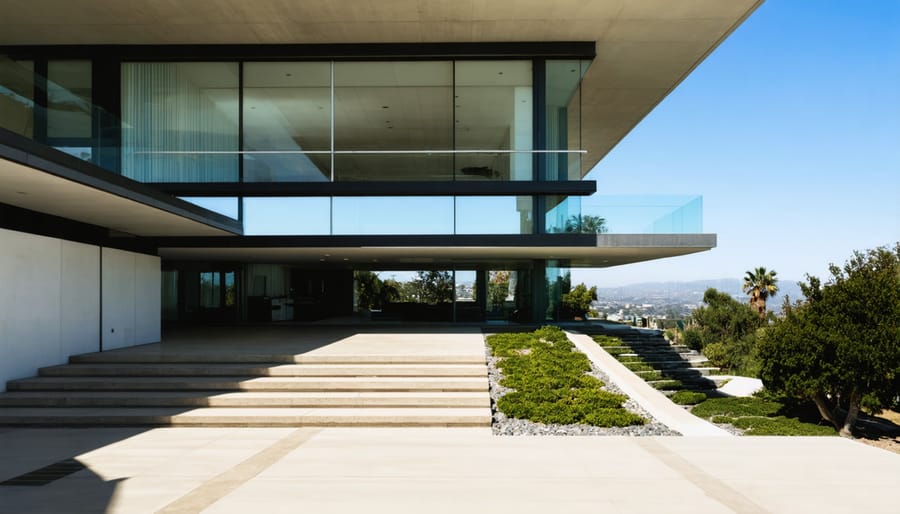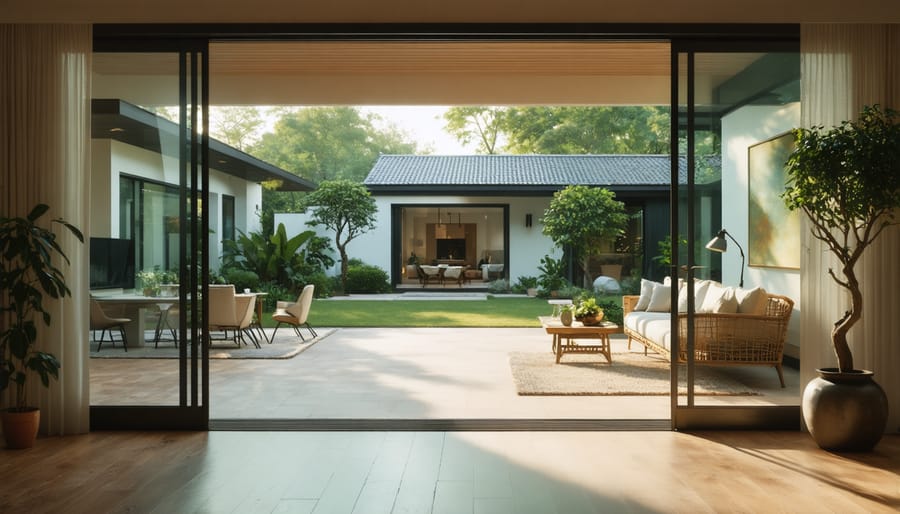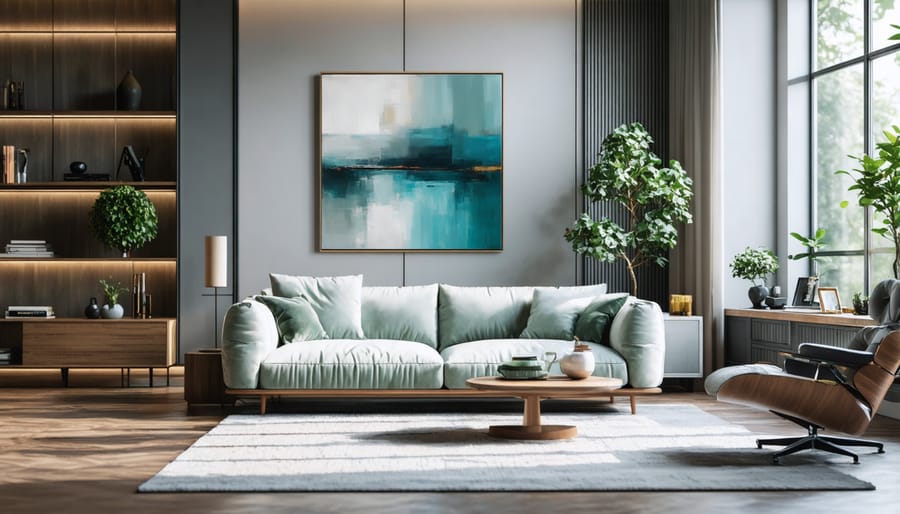Mid-century modern design revolutionized the way we think about home aesthetics, blending form and function in a way that continues to captivate designers and homeowners alike. Born from the architectural innovation of the 1940s through 1960s, this influential style has seamlessly integrated with today’s modern home architecture trends, offering clean lines, organic curves, and a timeless appeal that transcends decades.
At its core, mid-century modern celebrates simplicity and functionality, characterized by minimal ornamentation, natural materials, and an emphasis on indoor-outdoor living. This design movement emerged in response to post-war optimism and technological advances, introducing revolutionary concepts like open floor plans and large windows that brought nature indoors.
Whether you’re a design enthusiast or simply looking to refresh your living space, understanding mid-century modern principles can transform your home into a sophisticated sanctuary that honors both historical significance and contemporary comfort. From iconic furniture pieces to distinctive architectural elements, this enduring style continues to inspire and define what we consider modern living.
The Birth of Mid-Century Modern Architecture
Post-War Innovation
World War II dramatically shaped mid-century modern design, bringing a perfect storm of innovation and necessity to architecture and home design. The war effort’s focus on developing new materials and manufacturing processes led to exciting possibilities in home construction. Materials like plywood, steel, and aluminum – originally developed for military applications – found their way into architectural style identification and everyday home design.
The post-war housing boom meant architects needed to build quickly and efficiently, leading to streamlined designs and open floor plans that maximized space while minimizing construction costs. This period saw the birth of prefabricated housing elements and innovative building techniques that would define the era.
These developments weren’t just practical – they sparked a design revolution. The integration of indoor and outdoor spaces through large windows and sliding glass doors became possible thanks to advances in glass manufacturing. The signature clean lines and organic forms of mid-century modern emerged from this perfect blend of new capabilities and post-war optimism, creating spaces that felt both forward-looking and deeply connected to nature.
Key Architects and Influencers
The mid-century modern movement was shaped by several visionary designers who left an indelible mark on architecture and interior design. Ray and Charles Eames, perhaps the most recognizable names of the era, revolutionized furniture design with their iconic Eames Lounge Chair and innovative use of materials like molded plywood and fiberglass.
Architect Ludwig Mies van der Rohe’s “less is more” philosophy fundamentally influenced the movement’s minimalist approach, while his Barcelona Chair remains a coveted piece today. Florence Knoll transformed office design and brought modernist principles into everyday workspaces, creating pieces that were both functional and aesthetically pleasing.
Other notable figures include George Nelson, known for his innovative storage solutions and the iconic Marshmallow Sofa, and Arne Jacobsen, whose Egg Chair and Swan Chair designs perfectly captured the era’s organic yet sophisticated aesthetic. Finnish-American architect Eero Saarinen gave us the revolutionary Tulip Chair and table series, eliminating the “slum of legs” in furniture design.
These pioneers shared a common vision of making beautiful, functional design accessible to everyone, a principle that continues to resonate with modern homeowners.

Core Elements of Mid-Century Modern Design
Clean Lines and Organic Forms
Mid-century modern architecture is instantly recognizable for its striking balance between functionality and beauty. The style embraces clean, minimalist lines that create a sense of order and simplicity, while incorporating organic shapes that soften the overall aesthetic. Large windows stretch from floor to ceiling, dissolving the boundary between indoor and outdoor spaces and flooding rooms with natural light.
One of the most distinctive features is the flat or slightly angled roofline, which creates a dramatic horizontal emphasis. These streamlined profiles are often complemented by exposed structural elements like wooden beams or steel supports, celebrating the honest expression of materials and construction methods.
The integration of nature is paramount in mid-century design, with architects purposefully incorporating elements like indoor planters, natural stone walls, and courtyards. These organic touches help balance the geometric precision of the architecture. Open floor plans further enhance this flow, creating spaces that feel both spacious and intimate.
Materials play a crucial role in achieving this aesthetic. Natural elements like wood, stone, and brick are combined with modern materials such as steel, glass, and concrete. This thoughtful mixture creates visual interest while maintaining the style’s characteristic understated elegance. The result is architecture that feels both timeless and revolutionary, proving that good design never goes out of style.
Indoor-Outdoor Connection
One of the most striking features of mid-century modern design is its seamless connection between indoor and outdoor spaces. Large windows, sliding glass doors, and expansive picture windows are hallmarks of this style, creating an almost transparent boundary between your living spaces and nature. These design elements weren’t just aesthetic choices – they reflected the post-war optimism and desire to embrace a more open, natural way of living.
The emphasis on natural light isn’t just about aesthetics; it’s about creating a living space that feels expansive and connected to its surroundings. While original mid-century homes often featured single-pane windows, today’s homeowners can maintain this look while incorporating modern energy-efficient window treatments for better temperature control.
Bringing the outdoors in doesn’t stop at windows – mid-century modern design often incorporates interior courtyards, atriums, and strategically placed skylights. Plant life plays a crucial role too, with large indoor plants and carefully planned landscaping that seems to flow right into the home. Even interior color schemes often draw from nature, using earthy tones and organic materials to strengthen this connection.
To achieve this look in your own home, consider removing heavy window coverings, creating a dedicated indoor garden space, or adding a sliding door system that opens to your outdoor living area. Remember, the goal is to blur the lines between inside and outside, creating a harmonious living space that celebrates natural light and outdoor views.

Materials and Textures
Materials play a starring role in mid-century modern design, with an emphasis on both natural and manufactured elements that blend form with function. Wood, particularly teak, walnut, and oak, takes center stage in furniture and architectural elements, often featuring rich, warm tones that showcase natural grain patterns.
Glass is another hallmark material, used generously in large windows and sliding doors to create that sought-after indoor-outdoor connection. Designers often paired glass with steel frames, creating clean lines and geometric patterns that define the style’s architectural character.
The era embraced new manufacturing techniques, introducing materials like molded plywood, fiberglass, and plastic into home design. These innovative materials allowed for curved, organic shapes that were both beautiful and comfortable – think of the iconic Eames lounge chair combining molded plywood with leather upholstery.
In terms of textiles, mid-century modern spaces feature a mix of natural and synthetic fabrics. You’ll find wool, leather, and cotton alongside newer materials like vinyl and polyester. These fabrics typically showcase either solid colors or bold, geometric patterns that complement the clean lines of the furniture.
Metal elements, particularly brass, chrome, and aluminum, add subtle gleam and sophistication to spaces, often appearing as accent pieces, lighting fixtures, or furniture details. The combination of these various materials creates a balanced, timeless aesthetic that continues to influence modern design.
Incorporating Mid-Century Modern Elements Today
Architectural Features
Mid-century modern architecture embraces clean lines and functionality, with several distinctive features that set it apart. The most notable characteristic is the emphasis on bringing the outdoors in through large windows, sliding glass doors, and open floor plans. These elements create a seamless connection between interior and exterior spaces while flooding rooms with natural light.
Flat or slightly pitched roofs are another hallmark of this style, often featuring dramatic overhangs that provide shade and visual interest. The rooflines typically appear to float, supported by exposed beams that extend beyond the walls, creating a striking architectural statement.
Integration with the natural landscape is paramount, with homes often built on multiple levels to follow the natural contours of the site. Carports, rather than enclosed garages, are common features that maintain the style’s minimalist approach while providing practical functionality.
Materials play a crucial role in mid-century modern architecture. Authentic designs frequently combine natural elements like wood and stone with modern materials such as steel, concrete, and glass. These contrasting textures create visual interest while maintaining the style’s characteristic simplicity.
Interior spaces typically feature minimal interior walls and built-in storage solutions, reflecting the style’s commitment to functionality. Post-and-beam construction eliminates the need for many interior support walls, allowing for flexible, open living spaces that can be easily adapted to changing needs.
For those considering renovation or new construction, these architectural elements can be incorporated selectively to achieve a modern interpretation of the style while maintaining its core principles of simplicity, functionality, and connection to nature.
Color Schemes and Finishes
Mid-century modern design embraces both vibrant and neutral color schemes, creating spaces that feel simultaneously bold and balanced. The traditional palette draws heavily from the 1950s and 60s, featuring warm earthy tones like rust orange, olive green, and mustard yellow, often paired with rich browns and creamy whites.
For walls and larger surfaces, neutral backgrounds reign supreme. Think warm whites, soft grays, and beige tones that create the perfect canvas for statement furniture and décor. These understated bases allow the iconic furniture pieces and architectural elements to take center stage.
Accent colors play a crucial role in achieving authentic mid-century modern appeal. Deep teals, burnt orange, and vibrant mustard add personality to spaces through throw pillows, artwork, or statement chairs. For a more contemporary take, you might opt for softer versions of these classics – think sage instead of olive, or coral instead of orange.
When it comes to finishes, mid-century modern favors a mix of materials and textures. Wood tones, particularly walnut and teak, provide warmth and natural appeal. These are often complemented by metals like brass, copper, or chrome, which add brightness and sophistication to the space.
For a successful color scheme, follow the 60-30-10 rule: 60% dominant color (usually neutral), 30% secondary color, and 10% accent color. This creates visual harmony while maintaining the style’s characteristic boldness. Remember, the key is balance – mixing warm and cool tones while keeping the overall look cohesive and intentional.
Furniture and Decor Selection
When selecting furniture and décor for your mid-century modern space, focus on pieces that embody the era’s signature clean lines and organic forms. Start with iconic seating options like the Eames Lounge Chair or the Egg Chair, which perfectly capture the essence of this design movement. These pieces, while historically significant, continue to complement various modern design styles and contemporary interiors.
Look for furniture with tapered legs, smooth curves, and minimal ornamentation. Wood pieces in teak, walnut, or oak are particularly characteristic of the style. When choosing sofas and chairs, opt for simple, geometric shapes upholstered in solid colors or subtle patterns. The key is to maintain a balance between form and function.
Decorative elements should be purposeful and uncluttered. Consider abstract art pieces, sunburst mirrors, or geometric wall sculptures that echo the period’s aesthetic. Lighting fixtures play a crucial role – look for sputnik chandeliers, arc floor lamps, or table lamps with clean silhouettes and mixed materials like brass and glass.
For smaller décor items, incorporate elements that reflect the atomic age inspiration common in mid-century design. Think starburst clocks, abstract ceramics, and sculptural bowls. Keep your color palette true to the era with a mix of neutral tones accented by bold colors like mustard yellow, avocado green, or burnt orange.
Remember that authentic mid-century pieces can be expensive, but many quality reproductions are available that capture the style’s essence. When mixing vintage and contemporary pieces, maintain consistency in scale and proportion to create a cohesive look. The goal is to create a space that feels both nostalgic and fresh, paying homage to mid-century design while meeting modern living needs.

Mid-century modern design has proven itself to be more than just a fleeting trend, standing the test of time to become one of the most influential contemporary architectural styles. Its enduring appeal lies in its perfect balance of form and function, creating spaces that feel both sophisticated and livable. Even decades after its inception, the clean lines, organic shapes, and innovative use of materials continue to captivate homeowners and designers alike.
What makes mid-century modern truly remarkable is its versatility and adaptability to modern living. Whether you’re furnishing a compact urban apartment or designing a sprawling suburban home, the principles of this style can be successfully integrated to create meaningful, beautiful spaces. The style’s emphasis on bringing the outdoors in through large windows and natural materials resonates particularly well with today’s focus on wellness and environmental consciousness.
As we look to the future, mid-century modern design shows no signs of fading away. Instead, it continues to evolve, inspiring new generations of designers and homeowners to reimagine its core principles for contemporary living. Its timeless aesthetic, commitment to functionality, and celebration of honest materials make it not just a historical style, but a living, breathing design philosophy that will continue to shape our homes and spaces for years to come.
